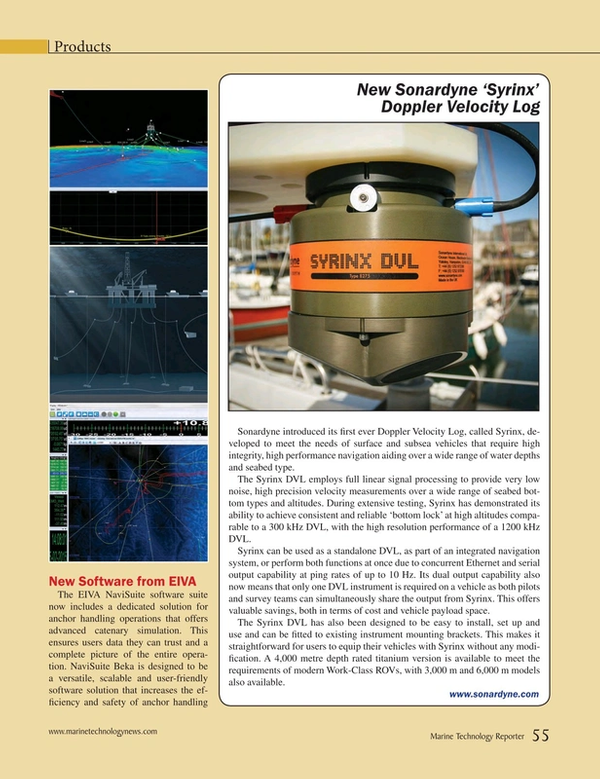
New Sonardyne ‘Syrinx’ Doppler Velocity Log
Sonardyne introduced its first ever Doppler Velocity Log, called Syrinx, developed to meet the needs of surface and subsea vehicles that require high integrity, high performance navigation aiding over a wide range of water depths and seabed type.
The Syrinx DVL employs full linear signal processing to provide very low noise, high precision velocity measurements over a wide range of seabed bottom types and altitudes. During extensive testing, Syrinx has demonstrated its ability to achieve consistent and reliable ‘bottom lock’ at high altitudes comparable to a 300 kHz DVL, with the high resolution performance of a 1200 kHz DVL.
Syrinx can be used as a standalone DVL, as part of an integrated navigation system, or perform both functions at once due to concurrent Ethernet and serial output capability at ping rates of up to 10 Hz. Its dual output capability also now means that only one DVL instrument is required on a vehicle as both pilots and survey teams can simultaneously share the output from Syrinx. This offers valuable savings, both in terms of cost and vehicle payload space.
The Syrinx DVL has also been designed to be easy to install, set up and use and can be fitted to existing instrument mounting brackets. This makes it straightforward for users to equip their vehicles with Syrinx without any modification. A 4,000 metre depth rated titanium version is available to meet the requirements of modern Work-Class ROVs, with 3,000 m and 6,000 m models also available.
www.sonardyne.com
(As published in the MAY 2015 edition of Marine Technology Reporter - http://www.marinetechnologynews.com/Magazine)
Read New Sonardyne ‘Syrinx’ Doppler Velocity Log in Pdf, Flash or Html5 edition of May 2015 Marine Technology
Other stories from May 2015 issue
Content
- Grasshopper Rides Falcon for 3D View of Dam page: 8
- Meet the AutoNaut page: 14
- WindSentinel Floating LiDAR Helps Cut Costs page: 22
- AUVs: Getting Defensive page: 28
- Dive into Norway's Subsea Valley page: 38
- d’ROP Bibby’ Hydromap’s Custom-built ROV page: 44
- MacArtney Launches NEXUS MK VII MultiPlexer page: 50
- EvoLogics Launches High-speed Mini-modem page: 50
- New Tracking Tech: Diver6 System page: 51
- Applanix’ Expanded Marine Product Portfolio page: 51
- Kongsberg’s New Marine Motion Sensor page: 51
- Falmouth Scientific’s New Chirp Transceiver page: 52
- Teledyne TSS Launches Powertrack Subsea Cable Tracker page: 52
- Valeport’s SWIFT SVP page: 53
- Dolphin Sea View 2D Sonar page: 53
- Fifth-Generation OCTANS Launched page: 53
- New Sonardyne ‘Syrinx’ Doppler Velocity Log page: 55
- New Software from EIVA page: 55
- Linden Photonics Debuts Hybrid Cables page: 56
- STR Unveils Rechargeable Battery Pack & Charger System page: 56
- New Switchable Magnet Launched as Tool for ROVs page: 57
- New Multibeam Z-Boat page: 59
- Seaperch Underwater Robotic Championships page: 60


